18 India Review | Stocks and Train Stations
18 India is marketed as a good introduction to the 18xx system that provides good setup variability and faster playtime. Does it meet these promises? Let’s find out in this review! So you want to be a Railroad Baron There is a group of games known as 18xx. They are train and business simulation-like games ... 18 India Review | Stocks and Train Stations
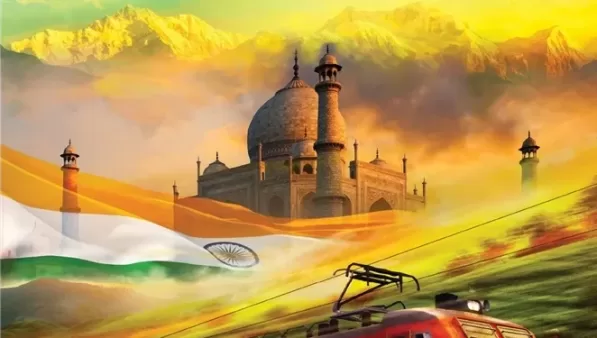
18 India is marketed as a good introduction to the 18xx system that provides good setup variability and faster playtime. Does it meet these promises? Let’s find out in this review!
So you want to be a Railroad Baron
There is a group of games known as 18xx. They are train and business simulation-like games that represent the rise of the railroad and railroad barons during the mid 1800s, hence the name of the series. Some games focus on the business side- building one’s stock portfolio, manipulating the stock market, buying and selling for profit. While others emphasize the operational side – building railroads, positioning train stations and purchasing new train models. 18 India seems to sit more on the operational side of the spectrum, and as the name suggests, is set in the Indian subcontinent. It is also my first 18xx; and the only train boardgame Ive played after the beginner friendly Ticket to Ride.
What’s in the Box
The game is published by GMT and comes in their typical high quality 3-inch thick bookshelf box. The cover art is that of a modern train, outright suggesting that the game plays till the modern era.
The 22×17 inch gmae board is beautiful, with a map of India and various graphs and charts and a useful setup guide. The game also includes 239 track tiles, more than 200 company certificates and bonds, more than a hundred tokens representing companies and commodities, 25 train cards, 5 player mats, 18 company charters, 1 open market board and turn and stock markers and a sheet of stickers. The components are extensive and of good quality.
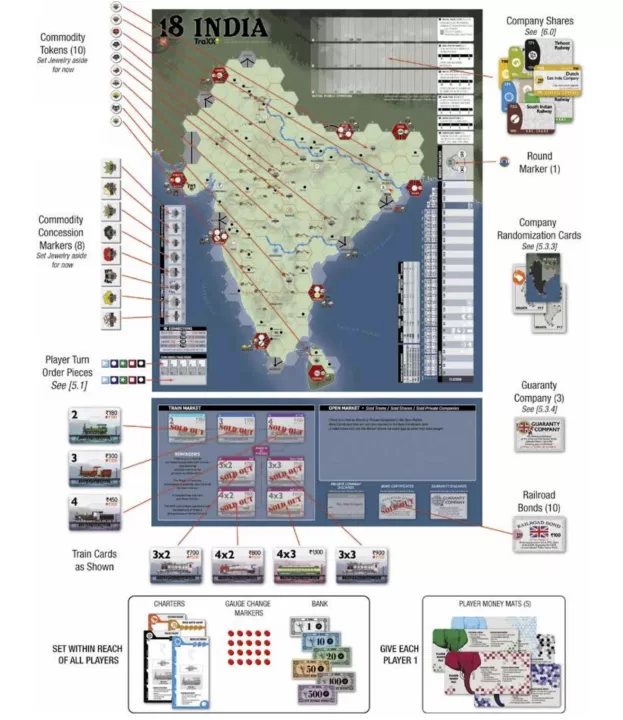
The rulebook setup illustrates the number of components in the game.
There are stickers included with the game and instructions on how to attach them. The company stickers don’t need to used since the companies and components are already color coded. However, the commodities stickers need to be attached.
There is also an errata in the box with replacement pieces. I find this refreshing since the publisher did not wait for a second printing to correct these errors.
Railroads and Revenues
The game setup is quite involved, but not difficult to do, especially since there is a handy setup guide on the upper right side of the board. This setup is also variable, allowing different companies to come into play per session.
There are basically 3 rounds per turn – one stock (SR)round, and two operational rounds (OR). During the Stock Round, players buy and sell company stocks, bonds, private companies. The player with the most stock certificates of a given company becomes the director or manager – there is subtle differences in the game; and gains operational control of the company. Private Companies provide special powers and a little bit of revenue during the Operational Rounds and bonds can be converted to company stocks later in the game.
During the OR rounds, players who have control of companies get to operate them. First they lay down up to 4 track tiles or upgrade 1. There are a number of these tiles and the most basic ones are colored yellow. Some tracks will have cities and towns in them with income values. They are placed in corresponding areas in the map with towns and cities, and generate revenue when they are part of a trains route.
There are also green, gray and brown tiles which are upgrades the basic tiles. The track aid shows the hierarchy of what tiles can be upgraded with what. These upgraded tiles don’t only represent upgraded railroad systems but also developing cities and towns that give more revenue as they are upgraded; and thematically represent developing cities and towns over the ages.

It’s a good idea to sort track tiles for easier gameplay
Players can then purchase train stations. They start out with one home station that is placed for free when a company becomes operational. Train stations are important since a train route has to contain at least one of its own stations within that route, and stations can also block routes for other companies.
After laying down tracks and stations, companies then run their trains, if they have any in their inventory, to earn income. Trains are designated by numbers, ie a 2-Train or a 4-Train, which indicates the number of cities it can service in its route. A train route has to start in a city and end in a city and has to have at least one of its train stations along the route for it to be a valid route. It can run on any track, even those laid by other players, as long as it meets the above requirements. It then adds all town, cities, and other bonuses along the route to get its revenue.
A company can have a maximum of 2 trains. So it can run two routes, with the caveat that it cannot run on the same tracks that the other train ran. Both revenues are added to get total income. The director/manager then decides whether to distribute this income as dividends or keep it as money for the company. If companies run their trains and declare dividends during their OR (Operational Round), then their stock price increases. It increases once for running the train/s; and proportionally on the amount of dividends declared. If they do not run trains nor declare dividends then their stock dips by a level for each it wasn’t able to do, i.e. it’s stock price will dip one level if it ran a train but didn’t declare dividends.
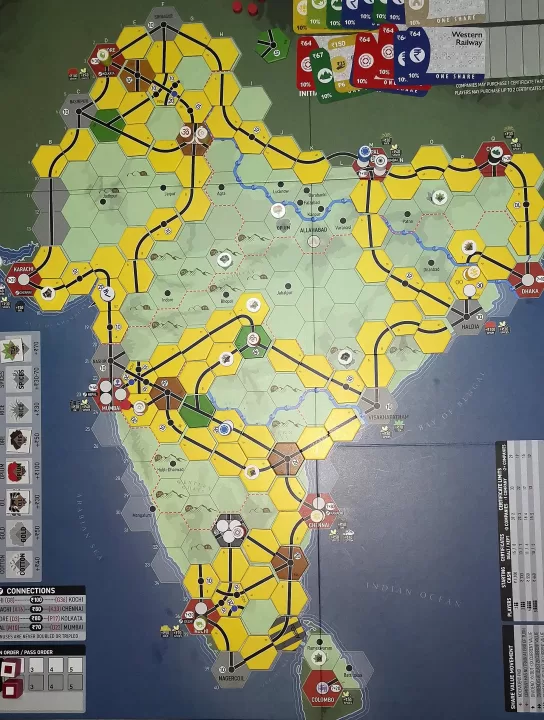
The Indian subcontinent takes shape
Companies can then buy and sell trains, usually getting better models if they can afford it. Companies can also buy stocks of other companies to supplement their revenue and increase their portfolio value which is important for endgame scoring.
As a player, you have your own mat where you place your stocks, bonds and monies. These assets are different from the company’s. 18 India ends when a stock reaches a market value of 400 or when the bank runs out of money. An end game formula determines who wins. The formula looks daunting, but makes more sense once you play the game.
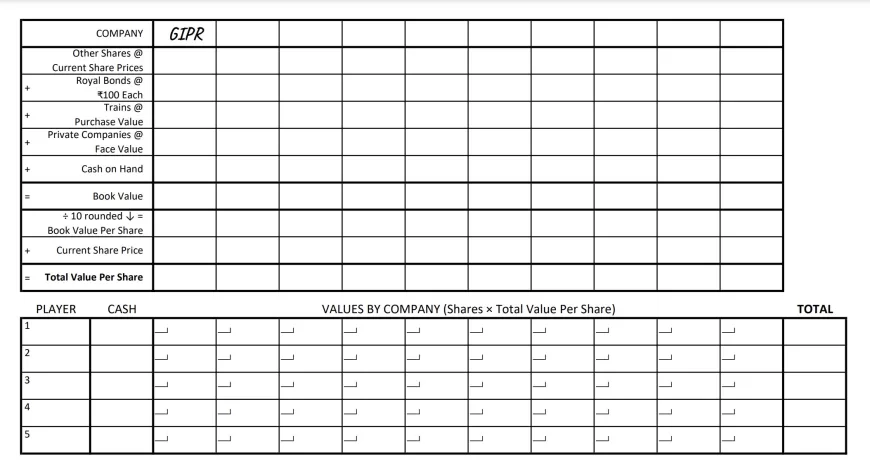
end game scoring summary care of dpbush in the BGG website
That is a brief summary of play. There are many more game nuance such as gauge changes, converting bonds to shares, Phases, IPO’s and commodities. You can find the full online rulebook here.
Words of Warning
A friend of mine described this game as advanced Ticket to Ride meets Acquire, which seems like a good description for people unfamiliar with 18xx. The gameplay description above already points to the game being more heavy on the operational side, which is also aided by the map being quite large with many cities and potential routes. I have not played other 18xx games, but online comments say there is less of the financial aspect in this game – i.e. less stock manipulation and no embezzlement of funds. If you enjoying laying down tracks and optimizing routes and train revenue you will enjoy this game. If you are looking for a more financially focused game, it may not be your cup of tea.
There is also some amount of ‘take that’ in this game. One can block other companies’ train routes with stations, you can use your companies to buy stocks another player would need, you can buy the better trains leaving other players’ companies without the best trains in the game. And the best trains in this game are game changers – they have revenue multipliers and can run an indefinite number of cities. So, if your companies are unable to purchase these, they will be at a disadvantage. Why are the starting trains so different from the end game trains? Unlike other 18xx games which simulates progress from the 1800’s to the early 1900’s, 18 India is simulating progress through the modern age.
There is a lot of mental math in the game. You will be computing for stock revenue percentages, money change, route revenue. None of them are particularly difficult, but you will be doing a lot of it. Getting change for transactions happens particularly often, and it can slow down the game. It might be a good thing to find apps or spreadsheets that automate stock computing and player/company cash on hand tallying.
The game also has a lot of components. Setup time can bog down if you do not organize your track tiles and company components. There are custom made game inserts specific to 18xx games, and there are also DIY solutions, just like my example above. Whatever you end up using, it essential to sort things for quicker setup and smoother gameplay.
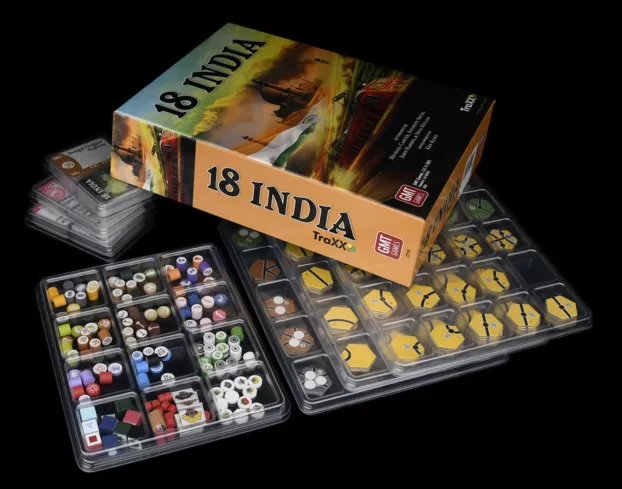
Game trays by CUBE4ME
The rulebook is short by GMT standards, but this is one of the few times I wished the rulebook was longer. Most everything you need to play is there, but it is written by someone intimately familiar with the 18xx system and certain concepts are glossed over. One example is the stock percentage chart in the map board. It is explained with a mere phrase and someone new to the system will likely not catch the purpose of the chart. The game definitely needs a FAQ to sort out some points.
A Thinking Man’s Railroad Game
Even with all the caveats above, 18 India is a compelling play. First of all, it is a gorgeous looking game with a minimalist stylistic sensibility. You wont see minis of trains nor cities, but the map and charts are nicely illustrated and clean in design. And watching the Indian subcontinent get crisscrossed and develop over time is a visual treat – you could almost imagine trains zipping thru growing cities as you play.
Despite the rulebook, the game is straightforward and veteran gamers will pick up the concepts after a turn or two. It is meaty, but not heavy rules wise. The player has a multitude of options, so much so that the game feels like a sandbox. Do you concentrate on being director and major stockholder of a few companies or spread his resources, dipping into every operating company without operating one yourself? Do you declare dividends, allowing you to buy more stock for your personal portfolio, or do you keep train revenues in the company so it can upgrade trains sooner? Do you let your controlled companies buy useless stocks to open up the underlying shares for you to buy in the stock round?
The map is also big, with cities and commodities scattered all around, lending itself to rail and tile design possibilities. Do you build towards the next city or do you try to pass by that lucrative commodity and win its concession revenue that stays with you for the rest of the game?
The take that portions of the game allow for some interesting shenanigans, but do not feel overbearing or too in your face. But be careful, as you might end up hindering your progress more than your opponent’s. Do you setup train stations at choke points with the possibility of cutting off routes to companies you might operate later on?
The design does seem to lend itself to interesting theorycrafting possibilities such as these. In a sense, I am glad the stock rounds are as simple as they are. Adding more complexity to them (as in other 18xx games) might make 18 India a bit too complex and too cumbersome to play for someone new to the system.
There are 18 companies in total and there will always be 10 companies per game. They all have their personalized starting locations in different locations in the map, have different IPO stock prices and a variable number of additional stations. This should make each game feel unique and greatly enhances replayability.
So does the game fulfill its promises? It is a good introduction to the system. It is deep in strategy without the burden of complicated rules. It has very good replayability thanks to its variable setup. But it is a long game and I do not see any other way around that. Using organizational aids like trays, inserts, or even baggies will streamline play. So will the use of poker chips instead of paper money. Or better yet, using a program or app to automate the cash of players and companies. But even with these aids, 18 India will still be a game exceeding 4 hours and likely reaching into 6 hours or more at 4 or 5 players. This is so, because the buildup is slow and it takes time to gain revenue momentum for both players and companies. Even with aids, gameplay will be 6 hours and up, as per my experience.
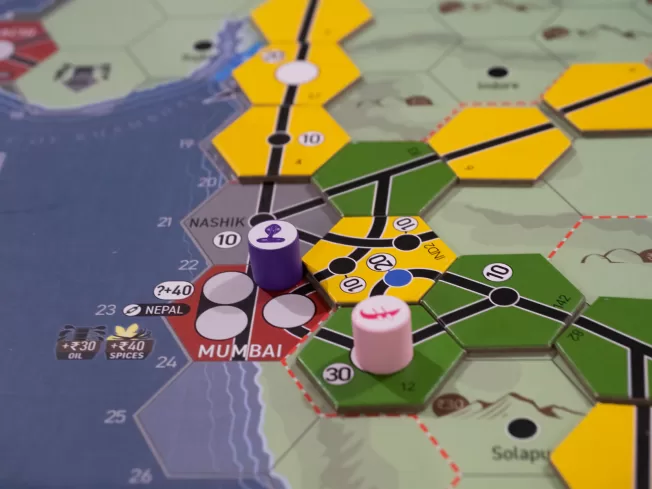
A strategic sandbox
So, is it worth a play or to own, given the game length? If you don’t mind the time sink, and you are a gaming enthusiast, the answer is a definite YES. I usually have a hard limit of game length for boardgames (3 hours), but this game is so good that I am willing to play this game again and again. As mentioned, there is much strategy and a myriad of possibilities in this game engine. If you like trains and laying tracks and watching your world and income grow, this is a no brainer. If you like deep strategy games with a dash of business and finance, you would be hard pressed to find a game as meaty and yet as approachable as this.
Thank you for reading our review for 18 India and lastly, Happy Holidays to you all and may you play more games in 2024!
Final Verdict: 8.5/10
Related:
Flashpoint: South China Sea Review | Tension in Southeast Asia
Kingdomino Origins Review | 3-way Dominoes

